*You can read this and all other articles of our website in 108 world languages by clicking the translate options on the left side 3 dots at the home page of our website. (check the bottom page for how to do this screenshots).
Rare collections of Mahātmā Gandhi
(Father of the Nation - India)
In remembrance of Father of the our Nation on Gandhi Jayanthi, we at TIT have tried to give you all some rare collections (INFOS, PHOTOS & QUOTES) of him.
Mahātmā
Gandhi
(Father of the Nation - India) |
|---|
 Gandhi in London, 1931 |
| Born | Mohandas Karamchand Gandhi
2 October 1869
Porbandar, Porbandar State, Kathiawar Agency, British Raj |
|---|
| Died | 30 January 1948 (aged 78)
New Delhi, Dominion of India |
|---|
| Cause of death | Assassination (gunshot wounds) |
|---|
| Monuments | |
|---|
| Citizenship | - British Empire (1869–1947)
- Dominion of India (1947–1948)
|
|---|
| Alma mater | - Alfred High School, Rajkot (1880 – November 1887)
- Samaldas Arts College, Bhavnagar (January 1888 – July 1888)
- Inner Temple, London (September 1888–1891)
- (Informal auditing student at University College London between 1888 and 1891)
|
|---|
| Occupation | - Lawyer
- anti-colonialist
- political ethicist
|
|---|
| Years active | 1893–1948 |
|---|
| Era | British Raj |
|---|
| Known for | - Leadership of the campaign for India's independence from British rule
- Nonviolent resistance
|
|---|
| Notable work | The Story of My Experiments with Truth |
|---|
| Political party | Indian National Congress (1920–1934) |
|---|
| Movement | Indian independence movement |
|---|
| Spouse | Kasturba Gandhi ( m. 1883; died 1944) |
|---|
| Children | - Harilal
- Manilal
- Ramdas
- Devdas
|
|---|
| Parents | - Karamchand Gandhi (father)
- Putlibai Gandhi (mother)
|
|---|
| Relatives | See Family of Mahatma Gandhi
C. Rajagopalachari (father-in-law of Gandhi's son Devdas) |
|---|
| Awards | Time Person of the Year (1930) |
|---|
|
|
|
In office
1924 |
| Preceded by | Abul Kalam Azad |
|---|
| Succeeded by | Sarojini Naidu |
|---|
|
|

|
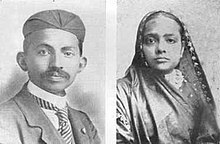
Gandhi (left) and his wife Kasturba (right) (1902)

Gandhi photographed in South Africa (1909)
Gandhi (right) with his eldest brother Laxmidas in 1886
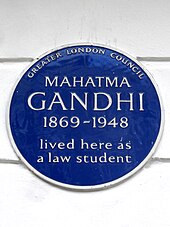
Commemorative plaque at 20 Baron's Court Road, Barons Court, London

This bronze statue of Gandhi commemorating the centenary of the incident at the Pietermaritzburg Railway Station was unveiled by Archbishop Desmond Tutu on Church Street, Pietermaritzburg, in June 1993.
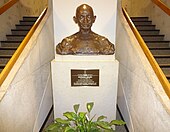
Statue of Mahatma Gandhi at York University
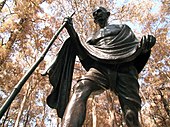
Mahatma Gandhi at Praça Túlio Fontoura, São Paulo, Brazil

Monument to Gandhi in Madrid, Spain

Gandhi in 1918, at the time of the Kheda and Champaran Satyagrahas
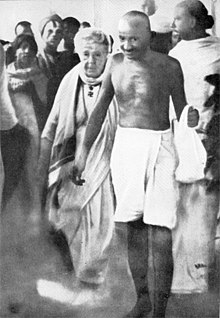
Gandhi with Dr. Annie Besant
en route to a meeting in Madras in September 1921. Earlier, in Madurai, on 21 September 1921, Gandhi had adopted the iconic cotton cloth ( vetti / dothi ) for the first time as a symbol of his identification with India's poor.

Gandhi spinning yarn, in the late 1920s
Mahatma Gandhi's Grandson and His Wife

An admiring East End crowd gathers to witness the arrival of Mahatma Gandhi, 1931

Gandhi talking with Jawaharlal Nehru, his designated political heir, during the drafting of the Quit India Resolution in Bombay, August 1942
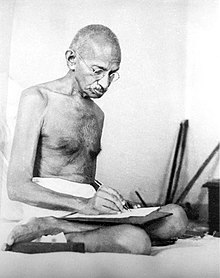
Gandhi in 1942, the year he launched the Quit India Movement

Gandhi with Muhammad Ali Jinnah in September 1944

Gandhi in 1947, with Louis Mountbatten, Britain's last Viceroy of India, and his wife Edwina Mountbatten

Gandhi picking salt during Salt Satyagraha to defy colonial law giving salt collection monopoly to the British. His
satyagraha attracted vast numbers of Indian men and women.

Gandhi with textile workers at Darwen, Lancashire, 26 September 1931

Gandhi with poet Rabindranath Tagore, 1940

Gandhi's last political protest using fasting, in January 1948

The Gandhi Mandapam, a temple in Kanyakumari, Tamil Nadu in India, was erected to honour M.K. Gandhi.

Gandhi's funeral was marked by millions of Indians.
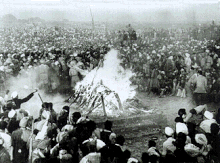
Cremation of Mahatma Gandhi at Rajghat, 31 January 1948. It was attended by Jawaharlal Nehru, Louis and Edwina Mountbatten, Maulana Azad, Rajkumari Amrit Kaur, Sarojini Naidu and other national leaders. His son Devdas Gandhi lit the pyre.

Memorial where Gandhi was assassinated in 1948. His stylised footsteps lead to the memorial.
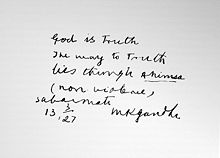
"God is truth. The way to truth lies through ahimsa (nonviolence)" – Sabarmati, 13 March 1927
There’s not a single person in the world who is untouched by the teachings of Mahatma Gandhi — the father of our nation — the chief advocate of ahimsa and satyagraha.
As the nation remembers Gandhi on his birth anniversary, take a look at some of his teachings…
His famous Quotes ....
“Be the change that you wish to see in the world.”
“An ounce of patience is worth more than a tonne of preaching.”
“In a gentle way, you can shake the world.”
“The greatness of a nation and its moral progress can be judged by the way its animals are treated.”
“A man is but a product of his thoughts. What he thinks he becomes.”
“Happiness is when what you think, what you say, and what you do are in harmony.”
“The weak can never forgive. Forgiveness is the attribute of the strong.”
“An eye for an eye only ends up making the whole world blind.”
“You must not lose faith in humanity. Humanity is an ocean; if a few drops of the ocean are dirty, the ocean does not become dirty.”
“See the good in people and help them.”
"The world has enough for everyone's needs, but not everyone's greed,"
"First they ignore you, then they laugh at you, then they fight you, then you win."
by
Share this article link with your friends and relatives if you like it. **இந்த கட்டுரையின் இணைப்பை நீங்கள் விரும்பினால் உங்கள் நண்பர்கள் மற்றும் உறவினர்களுடன் பகிர்ந்து கொள்ளுங்கள்.
****You can read this and all other articles in 108 world languages by clicking the translate options on the left side 3 dots at the home page of our website.
By
S.A.Sanjana
Talents Infinite Talents. ( TIT )
“Be the change you want to see globally,”
"ஒளியாய் ஒளிர்வோம்"
" Let's Shine like a Light "




































Comments
Post a Comment